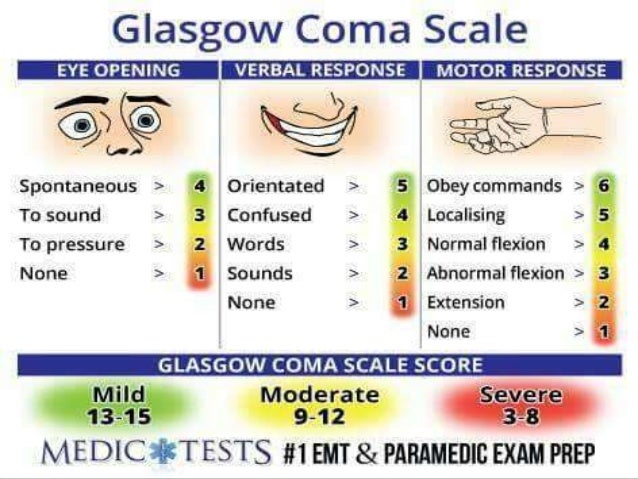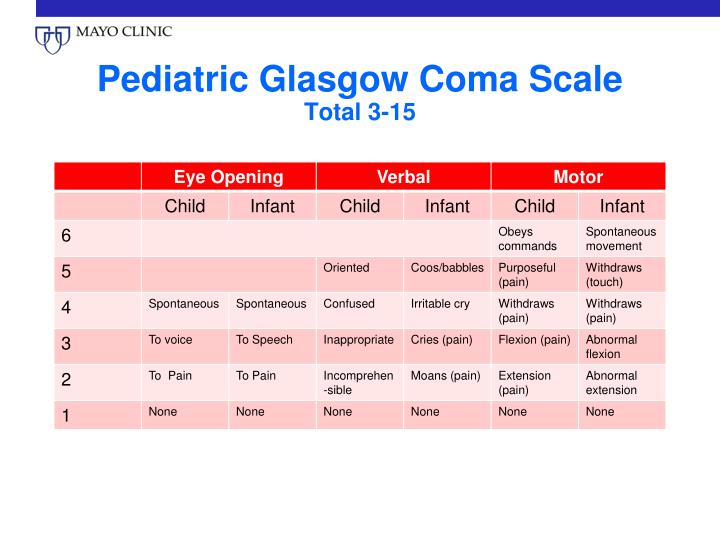
If however, the loved one is not opening their eyes spontaneously, you need to work through the following steps until a response is obtained. You would then move on to assessing verbal response, as shown in the next section. If the loved one is opening their eyes spontaneously, your assessment of this behavior is complete, with the loved one scoring 4 points. To assess eye response, initially observe the loved one for spontaneous eye-opening. * The highest possible score is 15 (fully conscious) and the lowest possible score is 3 (coma or dead).Įight is considered a critical score with 90 percent of loved ones in a coma at this level or below.
Pediatric glasgow coma scale professional#
The highest response from each category elicited by the healthcare professional is scored on the chart. There are three aspects of behavior that are independently measured as part of an assessment of your loved one’s GCS – eye-opening, verbal performance and motor responsiveness. That, in turn, makes communication between healthcare professionals much easier. The Glasgow Coma Scale is the most used tool in hospital and pre-hospital environments. Some of the advantages of the GCS is that it’s easy to use and it facilitates a common language and objective. Monitoring of the Glasgow coma scale serves as a guide to determine if the targeted level of an induced coma is achieved or thus need to be increased or tapered down depending on the result of your loved one’s GCS scoring.īy regularly assessing a loved one’s GCS, a downward trend in consciousness level can be recognized early, allowing time for appropriate interventions to be performed. In the case when your loved one is given medications intended to put them into an induced coma, it is also important to monitor their Glasgow coma scale to be able to know if there is already an overdose of medications because it can be equally lethal. It is commonly used in the context of head trauma, but it is also useful in a wide variety of other non-trauma related settings. The Glasgow Coma Scale (GCS) is a neurological evaluation tool that allows healthcare professionals to consistently evaluate the consciousness level of your loved one.
Pediatric glasgow coma scale how to#
HOW TO ASSESS GLASGOW COMA SCALE (GCS) IN ADULTS AND CHILDREN? In this week’s episode of “YOUR QUESTIONS ANSWERED” I want to answer questions that we get quite frequently as part of my 1:1 consulting and advocacy service! You can check out last week’s question by clicking on the link here. Do They Want to “Pull the Plug” Because of Organ Donation? This is another episode of “YOUR QUESTIONS ANSWERED” and in last week’s episode I answered another question from our readers and the question was The relatively high interobserver agreement for these scales makes them more suitable for the pediatric setting than the other three scales, since good agreement is essential for interpreting data reliably, both in clinical practice and for research.Hi, it’s Patrik Hutzel from INTENSIVECAREHOTLINE.COM where we instantly improve the lives for Families of critically ill Loved ones in Intensive Care, so that you can make informed decisions, have PEACE OF MIND, real power, real control and so that you can influence decision making fast, even if you’re not a doctor or a nurse in Intensive Care!



The disagreement rate was 0.10 or less for the 0 to IV Scale and for all items in the Simpson and Reilly and Jacobi scales. The disagreement rate was greater than 0.10 for verbal responses in the Children's Coma Score and Glasgow Coma Scale and for both items in the Children's Orthopedic Hospital and Medical Center Scale. The disagreement rate for the various items in the different scales ranged from a high of 0.20 to a low of 0.03. The results from both methods were generally concordant. Interobserver variability was measured by using disagreement rate and the κ statistic. The six scales were the Glasgow Coma Scale, the Simpson and Reilly Scale, the Children's Coma Score, the Children's Orthopedic Hospital and Medical Center Scale, the Jacobi Scale, and the 0 to IV Scale. Interobserver variability for six coma scales was assessed prospectively on a sample of 15 comatose children, by two physicians, in a double-blind fashion.


 0 kommentar(er)
0 kommentar(er)
